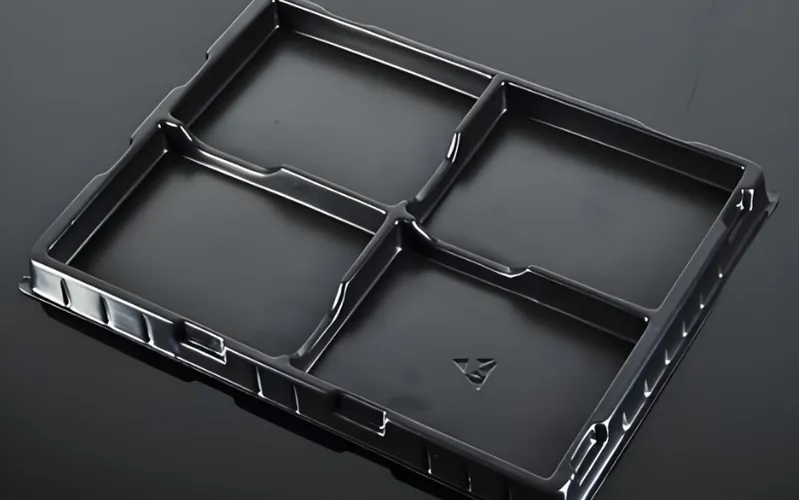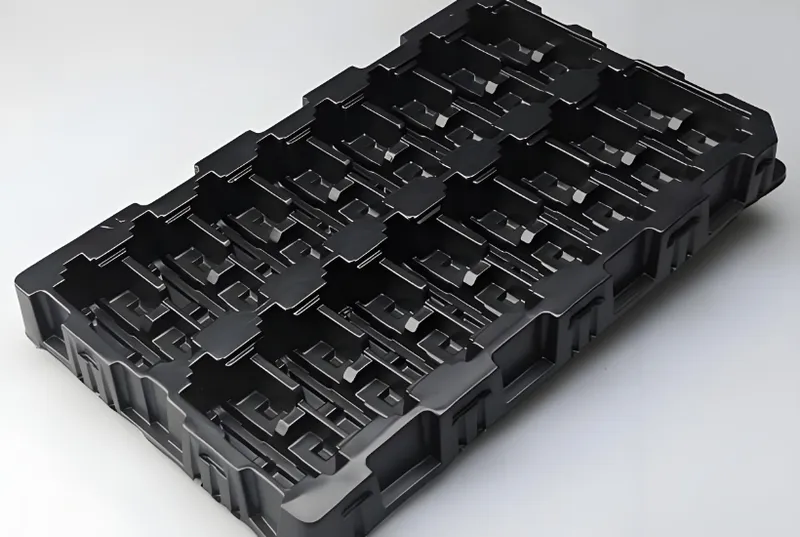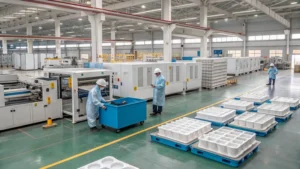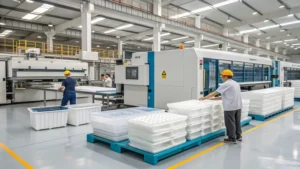
Thermoformed packaging is a versatile and cost-effective solution that shapes heated plastic sheets into custom molds1, creating packaging tailored to a variety of products. This method is widely used to protect, display, and preserve items across industries, from pharmaceuticals to consumer goods. But what products specifically benefit from thermoformed packaging2, and why? In this article, we’ll explore the types of products that rely on this packaging method, the reasons behind its use, and how it compares to other options.
- 1. What is Thermoformed Packaging?
- 2. What Products Commonly Use Thermoformed Packaging?
- 3. Why Do These Products Need Thermoformed Packaging?
- 4. What Are the Advantages and Disadvantages of Thermoformed Packaging?
- 5. Are There Unique or Less Obvious Products That Use Thermoformed Packaging?
- 6. How Does Thermoformed Packaging Compare to Other Methods?
- 7. Conclusion
What is Thermoformed Packaging?
Thermoformed packaging involves heating a plastic sheet—typically made from materials like PET, PVC, or polystyrene—until it’s pliable, then molding it into a specific shape. Once cooled, the plastic hardens into a custom package, such as a blister pack, clamshell, or tray. This process is prized for its ability to create precise, cost-effective packaging that enhances product visibility and protection.
Thermoformed packaging excels at providing tailored solutions for products needing security, visibility, and compliance with industry standards.

Curious about how this packaging method applies to specific products? Read on to discover its key applications and benefits.
Thermoformed packaging is only suitable for small products.False
While often used for small items like pills or earbuds, it can also be scaled for larger products like automotive parts or medical devices.
Thermoformed packaging is always the cheapest option.False
It’s cost-effective for moderate runs, but high-volume production might favor alternatives like injection molding.
What Products Commonly Use Thermoformed Packaging?
Thermoformed packaging is a go-to choice for products requiring custom-fit protection and appealing presentation. Its adaptability makes it essential across multiple sectors.

Pharmaceuticals, food items, electronics, and consumer goods depend on thermoformed packaging for its ability to safeguard and showcase products effectively.
| Product Type | Typical Packaging Form | Key Benefits |
|---|---|---|
| Pharmaceuticals | Blister packs | Tamper-evidence, unit dosing |
| Food Items | Trays, clamshells | Freshness, visibility |
| Electronics | Protective cases, trays | Shock absorption, organization |
| Consumer Goods | Clamshells, blister packs3 | Display, security |
Pharmaceuticals
Pharmaceuticals like pills and capsules often use blister packs—a thermoformed solution that offers individual dosing and tamper-evidence. These packs protect each unit from contamination and ensure regulatory compliance, making them a staple for companies like Pfizer.
Learn more about blister packaging in pharmaceuticals.
Food Items
Food products, such as meats or fruits, benefit from thermoformed trays4 and clamshells that preserve freshness and enhance shelf appeal. These packages can include barrier properties to block moisture and oxygen, extending shelf life in supermarkets.
Explore food packaging innovations.

Electronics
Electronics, from tiny components to devices like chargers, rely on thermoformed trays and cases for protection during shipping. Custom designs absorb shocks and keep parts organized, as seen with brands like Apple.
Discover electronics packaging solutions.
Consumer Goods
Toys, cosmetics, and tools often come in thermoformed clamshells or blister packs, which protect items while making them stand out on retail shelves. LEGO, for example, uses this packaging to display smaller sets clearly.
Read about retail packaging trends.
Thermoformed packaging is necessary for all products.False
It’s ideal for many items, but heavy or oversized products might require stronger alternatives like corrugated boxes.
Thermoformed packaging can fit any product shape.True
Its molding process allows for precise customization, accommodating even irregular shapes.
Why Do These Products Need Thermoformed Packaging?
Each product category has unique needs that thermoformed packaging meets effectively. Here’s why it’s the preferred choice:

Pharmaceuticals
-
Tamper-Evidence5: Blister packs show if a dose has been accessed, ensuring safety.
-
Unit Dosing: Individual compartments reduce contamination risks.
-
Compliance: Meets strict healthcare regulations with ease.
Food Items
-
Freshness6: Barrier films block spoilage factors like air and moisture.
-
Visibility: Clear packaging builds consumer trust by showing the product.
-
Portion Control: Perfect for pre-portioned meals or snacks.

Electronics
-
Protection: Cushions delicate parts against shocks and static.
-
Organization: Keeps components neatly arranged.
-
Branding: Enhances the unboxing experience with sleek designs.
Consumer Goods
-
Display: Ideal for retail pegs or shelves, boosting visibility.
-
Security: Tough plastic deters theft and damage.
-
Customization7: Matches the product’s exact dimensions for a polished look.
Thermoformed packaging is the only tamper-evident option.False
Shrink bands and sealed cartons can also provide tamper-evidence.
Thermoformed packaging excels at product visibility.True
Its clear, custom designs showcase products better than many alternatives.
What Are the Advantages and Disadvantages of Thermoformed Packaging?
Thermoformed packaging offers distinct benefits, but it’s not without trade-offs. Here’s a breakdown:

Thermoformed packaging balances customization and cost but may fall short for high-volume or heavy-duty needs.
| Aspect | Advantages | Disadvantages |
|---|---|---|
| Cost-Effectiveness | Affordable for moderate runs | Less viable for massive volumes |
| Customization | Precise shapes and designs | Limited by material thickness |
| Production Speed | Fast for prototypes and small batches | Slower than high-speed alternatives |
| Material Variety | Works with many plastics like PET | Some materials raise environmental concerns |
| Strength | Good for light to medium use | Not as strong as injection-molded options |
| Environmental Impact | Recyclable options available | Recycling varies by region and material |
This table shows thermoformed packaging shines for custom, moderate-scale applications but may not suit every scenario.
Are There Unique or Less Obvious Products That Use Thermoformed Packaging?
Beyond the usual suspects, other industries tap into thermoformed packaging for specialized needs.
Medical devices, automotive parts, and industrial components use thermoformed packaging for protection and precision.

Medical Devices
Surgical tools and diagnostic kits often come in thermoformed trays that maintain sterility and organization. Companies like Medtronic rely on this for their surgical packs.
Explore medical device packaging.
Automotive Parts
From fasteners to larger components, thermoformed trays keep automotive parts secure and organized during shipping and assembly, streamlining production lines.
Learn about automotive packaging innovations.

Industrial Components
Items like bearings or hardware use thermoformed trays to prevent damage and simplify inventory, as seen with suppliers like Grainger.
Discover industrial packaging solutions.
Thermoformed packaging is only for consumer products.False
It’s also critical in medical and industrial settings for protection and efficiency.
Thermoformed packaging suits heavy-duty applications.False
It’s less robust than alternatives like injection molding for heavy items.
How Does Thermoformed Packaging Compare to Other Methods?
Thermoformed packaging isn’t the only option—here’s how it stacks up:

Thermoformed packaging offers customization and affordability for moderate runs, ideal for custom-shaped, visible products.
| Packaging Method | Best For | Limitations |
|---|---|---|
| Thermoformed Packaging | Custom shapes, moderate volumes, visibility | Less cost-effective for huge runs |
| Injection Molding | High volumes, strong parts | Expensive tooling, longer setup |
| Cardboard Packaging | Eco-friendly, lightweight | Limited protection, less customization |
| Blow Molding | Hollow items like bottles | Not suited for flat or complex shapes |
This comparison highlights thermoformed packaging’s niche: custom, mid-scale needs with a focus on visibility.
Conclusion
Thermoformed packaging is a standout choice for products needing protection, visibility, and custom fits, from pharmaceuticals to industrial components. Its cost-effectiveness8 and versatility make it invaluable for moderate production runs, though it may not suit every scenario—like high-volume or heavy-duty applications. Businesses can harness its benefits to enhance product safety and appeal, ensuring items reach customers in top condition. If your product demands tailored packaging, thermoformed solutions might be the perfect fit.
-
Discover how custom molds can optimize packaging solutions for various products, enhancing protection and presentation. ↩
-
Explore how thermoformed packaging enhances product safety and visibility across different sectors. ↩
-
Learn about the advantages of blister packs in ensuring product safety and compliance in the pharmaceutical industry. ↩
-
Explore how thermoformed trays enhance product protection and shelf appeal, making them a popular choice in various industries. ↩
-
Explore how tamper-evidence packaging enhances safety and compliance in the pharmaceutical industry. ↩
-
Learn about the role of thermoformed packaging in preserving food quality and extending shelf life. ↩
-
Discover how customization in packaging can enhance product presentation and consumer appeal. ↩
-
Learn about the cost-effectiveness of Thermoformed Packaging and how it can benefit your business in moderate production runs. ↩








